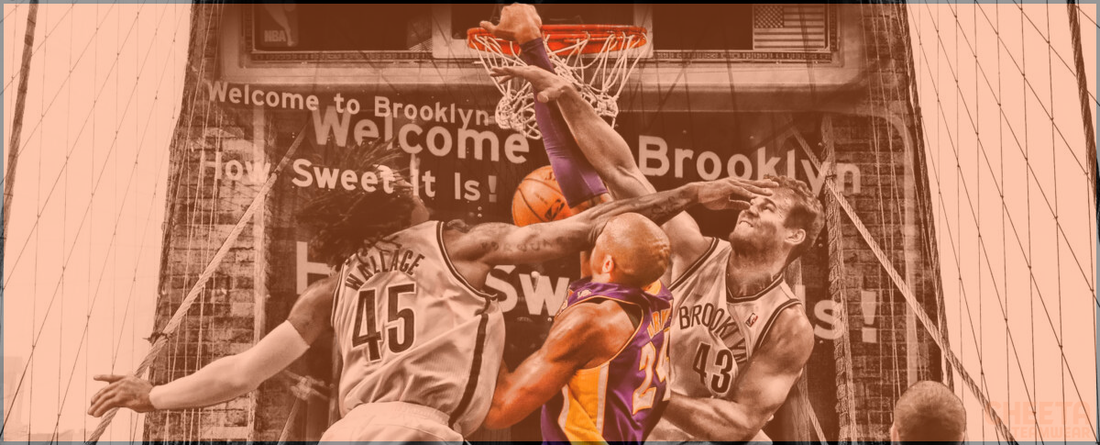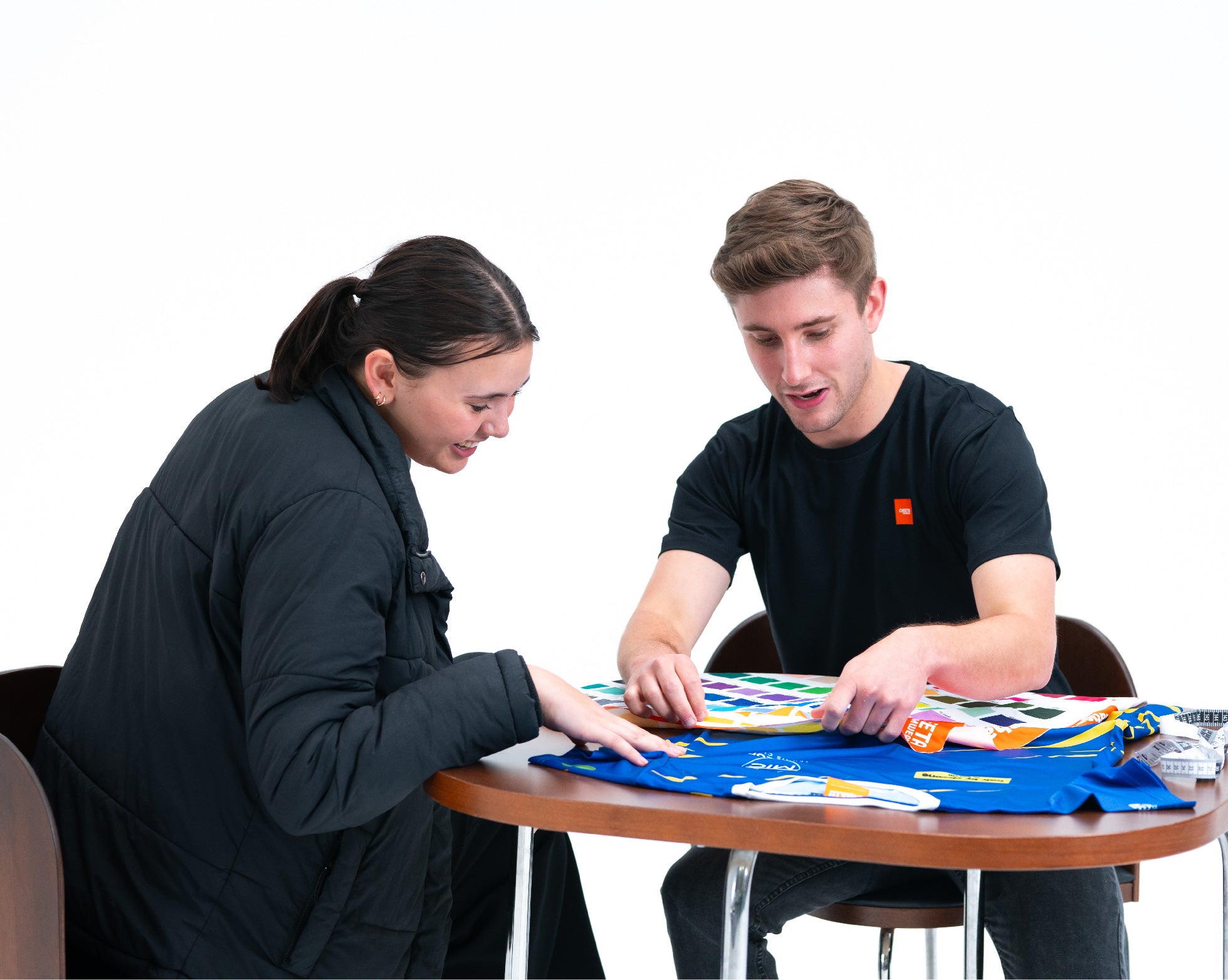Table Of Contents
How Jersey Numbers Are Chosen
NBA Jersey Number Rules and Positions
Jersey Numbers Outside of the NBA
NBA Jersey Number Change Rules
Most Successful & Iconic Jersey Numbers in NBA History
The Evolution of Basketball Jerseys
Conclusion
Key Takeaways:
Choosing the perfect fabric for your custom bucket hat ensures comfort, durability and brand impact. Cotton is breathable and classic, sublimated polyester lets full‑colour edge‑to‑edge prints, and terry towelling adds absorbency. Consider your climate, event or sport needs, then balance aesthetics with practicality to choose the ideal material for your branded headwear.
Basketball is a sport famous for its iconic jerseys and unique numbers. From #23 worn by the legendary Michael Jordan to the iconic #8 and #24 of the prodigy himself, Kobe Bryant. These uniform numbers hold great significance for players and fans alike. Don't worry, we know the basketball sneakers are just as famous! Are you team Adidas or Nike?
But have you ever wondered how jersey numbers are chosen? Do they mean anything beyond just a number on a player's back? Are these numbers just randomly chosen digits for each NBA player? We're huge basketball fans, and we have the answers for you! In this article, we will explore the NBA jersey number rules, positions associated with specific numbers, and the cultural significance behind it all.
Create Your Own Basketball Jersey Now!

How Jersey Numbers Are Chosen
NBA jerseys are like a canvas for players to paint a part of their stories. Jersey numbers are often chosen based on personal significance, team traditions, or the player's position. Some players opt for numbers that have familial or cultural importance, while others simply adhere to team or league guidelines.
Do jersey numbers mean anything?
Your jersey number is more than just a digit. Jersey numbers in basketball can have various meanings attached to them. Sometimes, players choose a number representing their birthdate or age (like Penny Hardaway's #1 or Kevin Garnett's former #21). Other times, it could be a tribute to a family member or mentor who influenced their lives.
LeBron James initially wore #23 as a tribute to his childhood idol - Michael Jordan. However, he later changed it to #6 when he joined the Miami Heat because that was the number he wore during his Olympic appearances. Honestly, he's a 4-time NBA MVP - it doesn't matter what number he wears he's loved by all!
How do I choose a jersey number?
Choosing your jersey number is an exciting decision at any level - whether you're a novice playing basketball in school or have taken your skills to a court outside of the schoolyard. So, how should you go about selecting your jersey number?
First you'll want to consider if your team or organisation imposes any restrictions regarding available numbers. Some teams may have certain digits reserved for specific positions or have retired numbers or jerseys. Ask your coach or team manager, they should have a list.
Also, whether you're the superstitious type or not, some organisations adhere to superstitions surrounding "unlucky" numbers like 13.
Secondly, think about what resonates with you as a basketball player wearing the same number for at least a whole season. Is there a particular athlete whose style or achievements inspire you? Consider wearing their number as an homage. Alternatively, if there is a significant date or favourite number associated with you, that could also be a great choice.
Last but never least, take into account the power of symbolism. A number may represent determination, strength, or success to you personally. Wearing that number on your jersey can serve as a reminder of the qualities you strive to embody on the court.
Here's a fun fact, in ancient Greece the numbers #11, #22 and #33 are revered as master numbers that command extra strength.

Cultural Significance of Numbers
Numbers hold deep cultural significance in various parts of the world. In Chinese culture, for example, certain digits are considered lucky or unlucky based on pronunciation and their association with positive or negative traits. This cultural influence can be seen even in NBA players' choices for their jersey numbers.
One prime example is Yao Ming, who wore #11 throughout his career. The number is considered lucky in China because "1" sounds like "prosper" in Mandarin. Yao Ming's choice reflected his identity as a proud Chinese athlete and resonated with fans who held onto their own cultural beliefs surrounding lucky numbers.
On the other hand, other numbers like #4 in China is considered extremely unlucky as it has a close resemblance to the word "death". Did you know that Chinese buildings often forgo a level 4? True story.
NBA Jersey Number Rules and Positions
Now that we have explored the cultural significance and personal meaning behind jersey numbers in basketball, let's take a closer look at the official NBA jersey number rules and the positions associated with specific numbers.
What Are The NBA Jersey Number Rules?
The NBA has specific guidelines regarding jersey numbers to ensure consistency and clarity during games. Here are some of the key rules:
- Numbers 0 and 00: These are both valid jersey numbers in the NBA. Players like Damian Lillard (#0) and Russell Westbrook (#0) have made these numbers iconic in recent years.
- Numbers 1-5: Traditionally, these numbers are reserved for guards or players who primarily handle the ball. Think of point guards like Chris Paul (#3) or shooting guards like James Harden (#13).
- Numbers 6-10: These numbers are typically worn by small forwards or swingmen who can play multiple positions. LeBron James famously donned #6 with the Miami Heat before returning to his #23 with the Cleveland Cavaliers.
- Numbers 11-15: Power forwards often choose from this range of jersey numbers, showcasing their versatility on both ends of the court.
- Numbers 16-20: These numbers are primarily worn by centres, who anchor the defence and control the paint. Former NBA stars Shaquille O'Neal (#32) and Hakeem Olajuwon (#34) embraced these digits throughout their careers.
Why is #6 banned in NBA?
Have you noticed the #6 missing from the court? Or heard that players such as Alex Caruso and LeBron James have "retired" their #6 jerseys? That's because the #6 has been permanently retired across the whole NBA in honour of former Boston Celtics player Bill Russell.
Russell's contributions to basketball went beyond his impressive skills on the court, as he was an influential civil rights activist during a time of racial tension in America.
To pay tribute to his legacy as a player and leader off the court, the NBA retired the number #6 throughout the league in 2022. It serves as a reminder of Russell's impact on and off the basketball court.
What Jersey Numbers Are Not Allowed In Basketball?
While most numbers are fair game in choosing a jersey number, there are a few exceptions. The NBA prohibits players from wearing certain numbers for various reasons. For example:
- Numbers 69 and above: Players cannot wear numbers #69 and above due to potential concerns over inappropriate or offensive associations.
- Number 0 combined with any other digit: To avoid confusion, players cannot wear numbers like 04 or 09, where zero is used alongside another digit.
- Number 6: Wearing the #6 is no longer sanctioned across the NBA. More on this below!
Does The NBA Allow Three-Digit Numbers?
No, the NBA does not allow three-digit numbers on jerseys. This rule aims to maintain clarity on the court and prevent any confusion during play. Remembering double digits is hard enough, why add three to the table!?
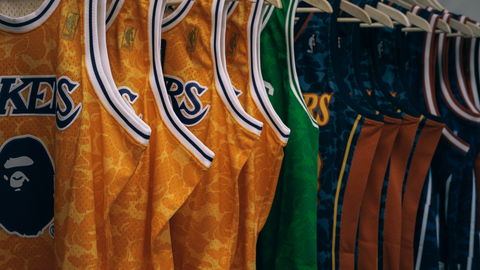
Jersey Numbers Outside of the NBA
While we have primarily focused on the NBA jersey number rules and their significance, it's important to note that basketball is a global sport with different leagues and organisations worldwide. In fact, basketball is in the top 10 most popular sports worldwide!
These leagues often have their own unique rules and practices when it comes to jersey numbers. Let's explore some examples:
International Basketball Federation (FIBA)
FIBA governs international basketball competitions, including the Olympic Games and FIBA World Cup. While FIBA generally follows similar guidelines to the NBA regarding eligibility for jersey numbers, there are a few differences. For example:
- In FIBA competitions, players can typically choose any number between 4 and 15, excluding 6, which is reserved for team captains.
- Some countries also have their own specific conventions or traditions when it comes to assigning jersey numbers. For instance, in Spain's ACB League, it is customary for players in certain positions (such as centres) to wear single-digit numbers.
College Basketball
College basketball has its own set of rules regarding jersey numbers. The National Collegiate Athletic Association (NCAA) oversees college sports in the United States and sets guidelines for jersey numbering practices. Here are a few key points:
- NCAA rule states that jerseys must be numbered from 0 to 5 using Arabic numerals (1, 2, 3, etc.) or Roman numerals (I, II, III).
- There are certain restrictions based on positions: guards usually wear #0 or #1; forwards may wear #2 through #4; centres typically wear higher numbers (#45 being commonly used).
- Unlike professional basketball leagues such as the NBA, where retiring jerseys is quite common among teams with legendary players, colleges usually reserve retirements for exceptional circumstances.
European Leagues
Basketball leagues across Europe also have their own unique practices when it comes to jersey numbers. In some cases, the traditions and conventions vary from country to country or even from team to team. Here are a few noteworthy examples:
- In the Spanish ACB League, jersey numbers may carry additional significance beyond player preferences. For instance, certain teams reserve specific numbers for iconic players or positions.
- In Italy's Serie A, jersey numbers often follow positional conventions similar to those in the NBA. For example, guards typically wear lower numbers (such as #1 or #5), while forwards and centres may wear higher digits (#7 or #15).
Create Your Own Basketball Jersey Now!
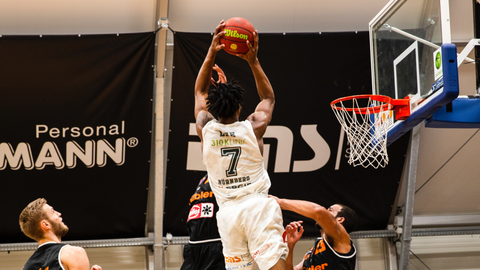
NBA Jersey Number Change Rules
In basketball, players have the freedom to choose their jersey numbers and the option to change them. Let's explore the NBA jersey number change rules and why teams sometimes retire certain numbers.
When A Number Can't Be Used
There are instances when a player on a team cannot use a specific, uniform number again. This typically occurs when a team decides to retire a player's number as a way to honour their contributions and impact on the franchise.
For example, after his sudden passing in January 2020, the Los Angeles Lakers retired both #8 and #24 in honour of one of the best players in the league, Kobe Bryant.
How often can NBA players change their numbers during the season?
According to league rules, players must apply for approval from the league office and their respective teams before switching.
Typically, players must wait until an offseason or an extended period without games before changing their numbers. This allows sufficient time for merchandise production and updates across various platforms. It also allows time for us fans to get our merchandise sorted for our favourite players!
Special exemptions for jersey number changes
In some cases, exceptions may be granted for immediate changes following significant events or circumstances. For example:
- When LeBron James returned to the Cleveland Cavaliers after his stint with Miami Heat, he was given special permission to switch back from #6 (which he wore with Miami) to his previous #23.
- Following Kobe Bryant's tragic passing, multiple players requested permission from the league to change their current jerseys to one of Kobe's iconic numbers (#8 or #24) as a tribute.
Why Do NBA Teams Retire Jersey Numbers?
Retiring a jersey number is the highest honour a team can bestow upon one of its players. It signifies that the player's contributions and impact were so significant that no other player on that team will ever wear the same number again.
Teams usually retire numbers to pay homage to famous players who have made an indelible mark on the franchise. These players often achieve extraordinary success, win championships, set records, and embody the values and spirit of the organisation.

Most Successful & Iconic Jersey Numbers in NBA History
Certain jersey numbers have attained legendary status due to iconic performances or associations with great players. Here are a few notable examples:
- #23: Michael Jordan
- #33: Kareem Abdul-Jabbar
- #32: Magic Johnson
- #6: Bill Russell
- #99: Wayne Gretzky (although primarily associated with hockey, it holds distinction across sports)
The Evolution of Basketball Jerseys
Basketball jerseys have come a long way since the sport's early days. From simple tank tops and singlets to elaborate designs, the evolution of basketball jerseys reflects changes in fashion, technology, and cultural trends. Let's look at how these jerseys have transformed over time.
Early Beginnings
In the early 1900s, basketball jerseys were functional yet basic. They consisted of sleeveless, woollen tank tops that allowed freedom of movement on the court. These jerseys often featured solid colours or simple patterns and were usually made from materials readily available at the time.
Introduction of Team Logos and Names
As basketball gained popularity, teams began incorporating their logos and names onto their jerseys. This helped establish team identities and create a stronger sense of belonging among players and fans.
Logos would typically appear on the front of the jersey, while team names were sometimes added to the back.
Colourful Designs and Sleeve Additions
In the 1970s, basketball uniforms started to become more colourful and vibrant. Bold designs featuring stripes, geometric patterns, and contrasting colours became common.
Some teams also experimented with adding sleeves to their jerseys during this period. However, this trend didn't endure in mainstream basketball but resurfaced years later in alternative styles.
Advent of Performance Fabrics
The introduction of performance fabrics revolutionised basketball jerseys in terms of breathability, moisture-wicking capabilities, and overall comfort for players.
Synthetic materials like polyester became popular due to their ability to withstand intense physical activity while keeping players dry.
Additionally, advancements in sublimation printing allowed for intricate designs and detailed graphics that would not fade or peel over time.
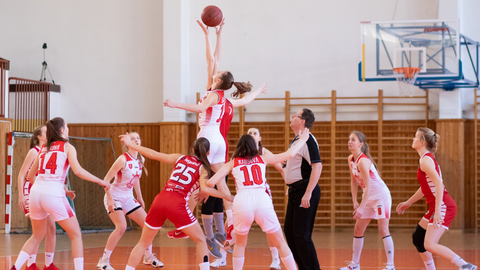
Alternative Jerseys and Special Editions
Over time, teams introduced alternative jerseys to create hype and engage fans.
These special edition jerseys often featured unique designs, colours, or retro-inspired aesthetics that paid homage to the team's history.
Fans eagerly anticipated these releases and frequently showed their support by purchasing and wearing these limited-edition jerseys.
Collaborations with Fashion Brands
In recent years, professional basketball teams have collaborated with fashion brands to create special jersey collections that blend sports and style.
This crossover has resulted in eye-catching and unconventional designs that challenge traditional jersey aesthetics.
The Rise of Throwback Jerseys

Throwback jerseys have gained tremendous popularity among basketball enthusiasts. These jerseys pay tribute to legendary players, historic teams, famous numbers, or specific eras in basketball history.
Basketball jerseys have evolved from simple tank tops into complex designs incorporating team logos, performance fabrics, and unique aesthetics. As the sport continues to grow globally, we can expect further innovations in jersey design that reflect changing tastes and styles.
Final Thoughts
Jersey numbers are more than just decoration on a basketball player's uniform; they carry personal meaning, cultural significance, and tell stories of greatness. Like a badge of honour.
From choosing a number that resonates with your aspirations to understanding the rules governing jersey selection in professional basketball leagues like the NBA - each digit has its own tale.

